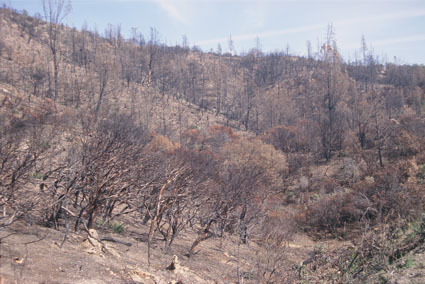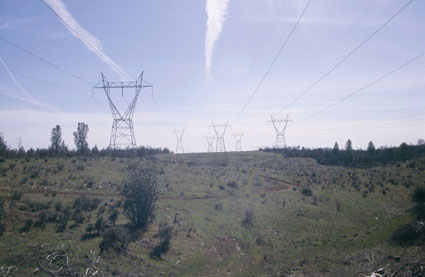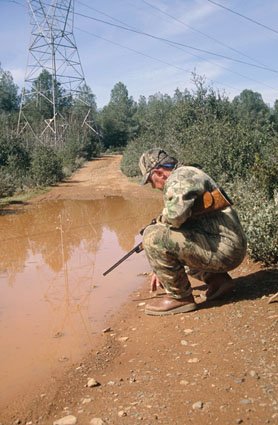Wild fires occasionally ravage large portions of the nation, laying waste to hundreds of thousands of acres of private land, National Forest, Bureau of Land Management properties, and state owned lands. Newspaper headlines and evening television news chronicle the destruction for weeks on end.
Although many consider these infernos the bane of only western states, they are not. Wildfires, large and small, burn every summer from coast to coast and border to border. Depending on your perspective, the results could be good or bad.
 Burns
Burns
What is left in the wake of these firestorms is the loss of immense big-game habitat. It takes years for these lands to recover, seriously affecting big-game hunters. However, not all hunters suffer the loss of these lands. In fact, predator hunters actually benefit from this chaos.
Fires clear the land of tall timber and smothering brush, the habitat where coyote, bobcat, and fox call home, raise their young, and hunt. But after the embers have died, the remaining lands left surrounding them, unburned, still hold these animals in the same numbers. They’ve just moved into the unburned areas.
The way to make burns pay off is to make your stands along “edge cover” — that dividing line between remaining cover and blackened lands. Set up right out in a burn using remaining stumps, boulders, or downed timber for a blind, then call into the surviving heavy cover. The predators are still there and will respond.
Any animal that comes to your calling must show itself when it enters open ground offering a clear shot at moderate or close range depending on how far into the burn you make your stand. I set up 100 to 200 yards out. That gives me more area to watch and more time to watch animals moving toward me as I position myself for the shot. Calling over the same ground before fires swept the land clean; you would never see these same predators until they were right on top of you. That is the advantage of using burns for stands.
Choosing unusual or unconventional places is especially important to traveling predator hunters. Wherever I go, I always take my calling gear. That means I’ve done a lot of calling in country I’ve never scouted. It means you have to get good at quickly sizing up or passing on areas that you believe can or can’t produce results. We all know our home turf like the back of our hands. Outside that comfort zone requires different thinking.
Waterways
Nearly all areas that hold the three major species of predators (bobcat, coyote and fox) also have creeks, streams, rivers or lakes. Even in desert country where waterways are bone dry for most of the year, these places still exist and are important.
Predators often follow natural waterways to drink, travel, check scent signs, and certainly hunt for the abundant life living nearby. Waterways work like a magnet, pulling predator and prey species in and concentrating animals. They leave their tracks in soft sand or mud, plainly showing their size, numbers, and time of passage. Tracks tell the predator hunter whether he is in fertile ground or not, and where to choose a stand. All this information is available before we put a call to our lips.
Set up with a good view both up and down a creek or streambed, either wet or dry. Also, try to get a bit of elevation if possible. A small rise, hummock, or rocky ridge gives you the advantage. Allow plenty of time when hunting waterway stands. Coyotes and fox will move long distances along these natural pathways to reach a call. Stands of at least 25 minutes should be the rule, not the exception. In hilly, chopped up country where calls cannot easily get out, consider staying an extra 10 minutes to see what happens.
Boats
Larger waterways such as streams, rivers, or lakes provide unique predator hunting opportunities using boats. Some of the most remote and productive lands are bounded by water.
A 20-minute boat ride can put you in country where few have ever set foot, and even fewer have blown a predator call. I have two such places I frequently hunt. One is a large river, the second, a seven-mile long lake. Also worth considering is float hunting downstream with the current, going ashore to call every quarter or half mile. With current you don’t need a motor. Oar power works just fine and is quiet. Small boats or canoes fit this scenario perfectly. One vehicle is parked downstream where the float hunt will end, a second taken up to the starting point for putting in the boat.
Rights-Of-Way
Another rarely considered, but often-productive location open to predator hunters are rights-of-way for public power utilities. These can be transmission lines from dams, impoundments, and other electric facilities that run from a few to hundreds of miles through varied terrain and cover.
Generally, but not always, these public pathways are held by federal or state governments with access to the public open under certain limitations. For example, entry for hunting on foot is often allowed, but vehicles may not be used on work roads maintained by the same agencies. Check the rules, and be sure to check the ATV options.
Another plus for these special properties and easements is that they often pass through large tracts of game rich private lands where no public access is allowed. Yet a short hike into right-of-way lands puts you in the gunner’s chair to reach predators that have never heard a call before.
Most federal and state right-of-ways are fenced to mark the boundary line between public and private property. In almost every case, predators have established “go unders” to get past these barricades, showing you their travel routes. Gates for utility lands are often locked, but a phone call or trip to the local utility office can secure permission to walk in and hunt on big tracts of very productive lands overlooked by other predator hunters. They can open up thousands of acres of new hunting opportunities.
Another type of right-of-way lands well worth investigating are federal, state, or county water district canals and aqueducts maintained by irrigation districts. These man-made waterways often wind through private lands offering the same kind of access to closed properties that power-utility easements do and opportunities to call the uncalled predators living in them.
Some canal systems run for dozens or even hundreds of miles in the case of state- or federal-irrigation systems that span half a state.
Weather
Weather changes that benefit us most are rain or snow. In low and mid-lands where snow does not fall, a good rain sweeps the area clean of all previous sign.
The morning after rains pass, any tracks you cut are just hours, and possibly, only minutes old. That means a coyote, fox, or bobcat can still be in easy calling range. Predatory animals get out early and hunt hard for a meal after weather events like this pass.
Tracks are clear, sharp at the edges, their size and direction evident. Look in sandy soil, clear, soft ground in the open, or along the edge of secondary, unpaved and four-wheel-drive roads. Predators travel them for the easy access they offer and to stay out of wet, dripping brush and grass.
Over snow, tracks and what they reveal is even clearer. A novice can follow and interpret them. Their direction, size, number of animals, if they were running, wandering, or hunting another set of tracks is easily doped out. One of the greatest advantages of getting out in fresh snow is actually being able to see a coyote, fox, or bobcat moving out in front of you over an all white background.
Any situation like this, regardless of how far off the animal is, provides greatly increased odds of calling them back to you. You have all the aces. You can quickly choose a stand and get comfortable before calling. You can watch the animal turn and come your way, and prepare for your shot long before it comes into range. And, you’ll take predators in prime conditions for pelts.
Most of these hunting opportunities are not considered and easily passed up by the majority of hunters. Almost any piece of country from east to west, border to border, will offer one or more of these hidden gems — a chance to hunt large sections of new country generally untouched. That means calling virgin ground without competition, and that translates into the awesome adventure all Xtreme predator hunters strive for.
Featured image: Alan Clemons






